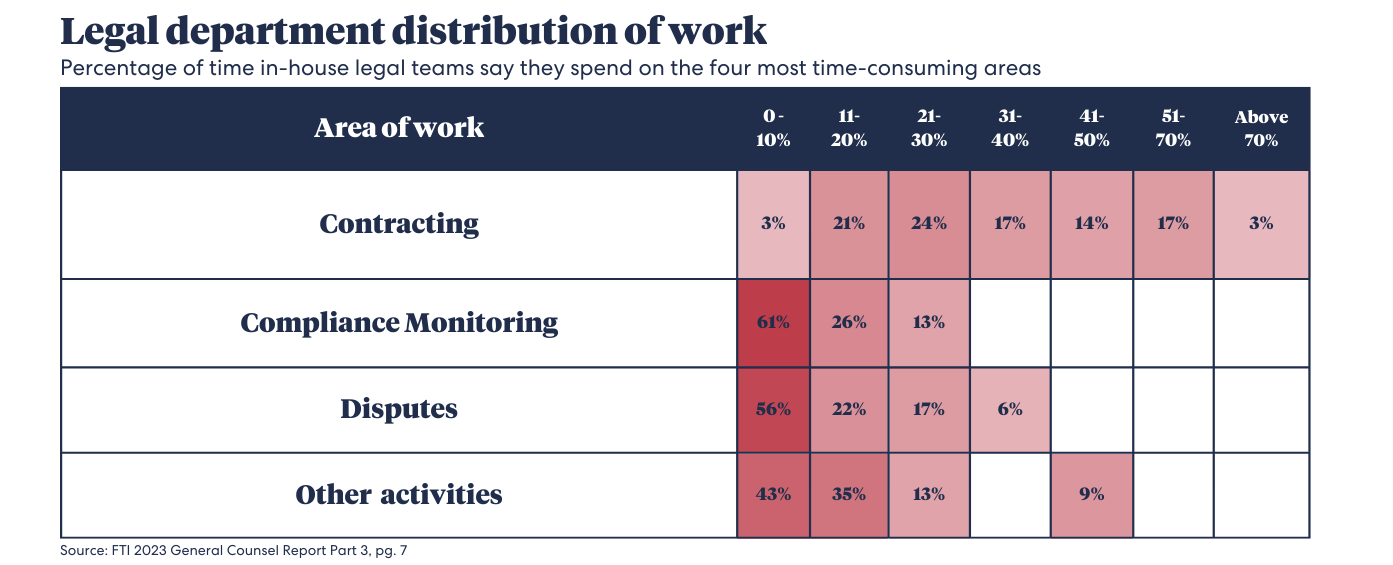
Contracts are a vital part of every business. They serve as the foundation for the exchange of goods and services and outline the terms and conditions of business relationships.
Proper contract management allows organizations to ensure compliance, mitigate legal and financial risks, and maintain healthy relationships. On the flipside, poor contract management can cost businesses 9% of their bottom line.
Given the close business alignment necessary for effective contract management and the immense costs of poor contract management processes, it’s little wonder that 99% of corporate legal departments handle all or some of their contract management in house. Because of this, legal teams spend far more time on contracting than anything else.
To unlock their potential value, a foundational understanding of contracts must be established. Here’s a comprehensive overview of the meaning, types, elements and lifecycle of contracts.
What are contracts?
Contracts are legally binding agreements. They outline the terms and conditions of the agreement (such as the goods or services being exchanged), the responsibilities and obligations of each party and the consequences of non-compliance.
Common types of contracts
While all contracts serve as the legal framework for an agreement, there are many different types of contracts; each with its own nuances to navigate. Types of contracts include:
- Unilateral and Bilateral Contracts: In unilateral contracts, one party promises to do something if the other party performs a certain act. In bilateral contracts (which are much more common), both parties promise to perform certain acts.
- Express and Implied Contracts: In express contracts, the terms are explicitly stated; in implied contracts they are not, but they can be reasonably inferred.
- Executory and Executed Contracts: An executory contract is one where one or both parties have not yet fulfilled their obligations; when both parties have fulfilled all obligations, it becomes an executed contract.
- Voidable and Void Contracts: A voidable contract can legally be cancelled by one of the parties; a void contract is not legally enforceable. A contract may be void if it fails to satisfy certain conditions, such as legal purpose (for example, a contract to commit a crime is void).
Taking the discussion a step further, there are many types of contracts that are common to businesses which fall into one (or more) of the above categories. The types of contracts a business handles depend on factors like its size and industry, but some of the most common business contracts include:
- Master Service Agreements (MSAs): Long-term contracts that establish the terms and conditions of a business relationship.
- Statements of Work (SOWs): Outline the scope of work, deliverables, timelines, and costs of a specific project or service. When an MSA already exists between two parties, an SOW can be used to easily govern a specific agreement.
- Non-Disclosure Agreements (NDAs): Prohibit parties from disclosing confidential information.
- Procurement Contracts: Establish the terms and conditions of the purchase of goods or services.
- Clinical Trial Agreements (CTAs): Define the terms and conditions of clinical trials – CTAs are used to conduct research on new medicines, medical devices or therapies. CTAs cover things like the study protocol, responsibilities and compensation.
- Licensing Agreements: Establish the terms and conditions of the use of intellectual property or technology.
- Partnership Agreements: Define the terms and conditions of a partnership between two organizations, allowing them to collaborate on projects, share resources and more.
- Derivatives Contracts: Commonly used for speculation, hedging, risk management and arbitrage, derivatives derive value from an underlying asset, such as currencies, stocks or interest rates. Financial Services firms use a variety of Master Agreements, such as ISDA, GMRA and GMSLA, to cover trading relationships in derivatives and other financial products. Such arrangements can also be supported by a contractual guarantee.
- Merger & Acquistion (M&A) Agreements: Facilitate the process of two companies merging, or of one company acquiring another. M&A agreements detail the terms and conditions of the transaction, such as purchase price, deal structure, rights and obligations.
Essential Elements of (Enforceable) Contracts
Regardless of the contract type, certain parameters must be satisfied. To be legally binding, a contract must include essential elements such as:
- Offer and Acceptance: There must be a clear offer made by one party and an acceptance of that offer by the other party.
- Consideration: Each party must provide something of value in exchange for something else.
- Competent Parties: Each party must legally be able to enter into a contract (meaning they must meet certain conditions, like being of legal age and having the mental capacity to understand the agreement).
- Legal Purpose: The contract must have a lawful purpose – it cannot violate (or cause any violation of) the law or applicable regulations.
- Free Consent: Parties must enter into the agreement voluntarily and without coercion.
- Capacity: Each party must have the legal authority to enter into the contract. For example, an intern at a Fortune 500 company likely doesn’t have the authority to enter into a multimillion-dollar purchase agreement.
It may seem that legally binding contracts have to satisfy a wide range of conditions – and they do – but so long as you understand the nuances of the contract type and your specific situation, this isn’t as daunting as it may appear. For example, a purchase agreement in which one party agrees to purchase goods or services from another party in exchange for payment is an enforceable contract.
Contract Lifecycle Management: Phases and Common Issues
Recent years have seen significant buzz around Contract Lifecycle Management (CLM) technology, but understanding the contract lifecycle and how to drive value through proper contract lifecycle management requires more than a tech tool.
Broadly speaking, there are five distinct phases of the contract lifecycle:
1. Intake and Allocation
This phase involves collecting and organizing all relevant contract data and assigning resources. Relevant data may include counterparties, key dates, obligations, performance metrics and more; it should be entered into a centralized location for easier management and monitoring of the contract throughout its lifecycle.
Issues with contracting efficiency often occur during this initial phase. Many times, this is due to a lack of standard intake processes, decentralized processes or intake processes that do not support matter triage, allocation, status tracking or reporting.
2. Drafting and Preparation
The drafting and preparation phase is when contract creation occurs. One of the areas organizations often struggle with in this phase relates to creating first drafts – an issue that can be mitigated (in part) with templates and playbooks.
At this point, teams must be cognizant of the contract’s goal and scope in order to draft terms and conditions (such as delivery schedule, payment terms and other relevant conditions). The drafted contract must comply with relevant laws, regulations and industry standards, meet the requirements of all stakeholders, and include all necessary essential elements of enforceability.
3. Negotiation
During negotiation, parties align on the terms and conditions of the contract. If an organization has history with a given counterparty, they may be able to expedite the negotiation phase by accessing previous agreements.
If businesses lack standardized processes and legal escalation paths, they may face inconsistently negotiated terms or long contract cycle times.
4. Authorization & Signing
At this stage, the parties have agreed to the terms and conditions of the contract, and those who are authorized to sign do so.
Some of the issues commonly seen during the authorization and signing phase relate to the lack of a signature policy (and in turn, lack of clarity on signing authority), or an inability to automatically manage performance obligations (and uncertainty around the final terms).
5. Storage and Management
In this post-execution phase, the contract's performance is monitored. This includes reporting on key performance indicators (KPIs), ensuring obligations are met and updating the contract as necessary.
One of the most common issues in this phase comes down to businesses lacking a “single source of truth” -- a database where all executed agreements are stored. The impact of this shortcoming is clear. On average, 68% of contract professionals search for completed contracts at least once a week – once they locate the contract, they generally spend another hour at least finding the relevant section or language.
When organizations do have a database, it can streamline the negotiation phase, as it allows teams to easily find counterparty history (including counterparty profiles and previous agreements), in turn driving efficiency. Another critical element relates to reporting and analysis on topics such as most negotiated provisions; this information helps legal departments continuously improve contracting effectiveness.
The contract may be renewed or extended when necessary; otherwise, the contract is terminated (either because the contract term expires, the terms and conditions are violated or both parties agree to end it).
Lastly, contract dispute resolution is sometimes necessary. Paths to resolution include contract remedies (such as compensation), arbitration, alternative dispute resolution (such as mediation) or litigation.
Benefits of Effective Contract Management
When contract management best practices are followed, organizations enjoy benefits ranging from streamlined repapering and regulatory response to better business outcomes.
After optimizing contracting, we’ve seen clients enjoy results like:
- 50% reduction in clinical trial agreement (CTA) cycle times
- 98% accuracy rating
- 75% reduction in time-to-delivery of new workflows
Contracts are the lifeblood of every organization; most contract bodies hold immense (and untapped) potential value. Get in touch to learn more.


